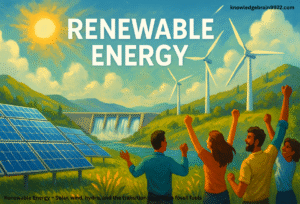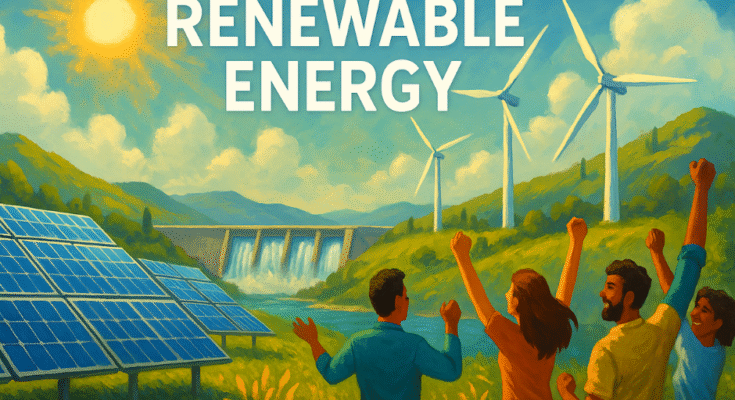
Renewable energy: the Transformation, Solar, Wind, and Hydro Steer free of fossil fuels. Overview
In a world that is struggling with climate change, air pollution changes, and the depletion of fossil fuel reserves, renewable energy has become a crucial component for a sustainable and long-term future. Technology that utilizes water, wind, as well as sunlight can diversify portfolios of energy sources, decrease carbon dioxide emissions, and reduce carbon emissions from power systems. Three main renewable sources of energy–wind, solar hydropower and solar energy are examined in this piece, as well as their roles in the overall change away from coal natural gas, and oil. Following a discussion of the basic principles behind each advantages, disadvantages, as well as the most recent advancements then we’ll talk about the integration of grids, storage alternatives legislation frameworks, as well as how to create a totally renewable energy systems.
- Solar Power
1.1 Technology of Photovoltaics (PV)
The photovoltaic effect is the reason why solar cells convert sunlight into electricity. Crystalline silicon cells, that yield efficiencies ranging from 15 to 22 percent, are utilized in a majority of commercial panel. However, they have a lower efficiency technological advances in thin-film techniques such as copper-indium-galium selenide (CIGS) and Cadmium Telluride are expected to reduce production costs. Rooftop installations provide the possibility of distributed generation close to consumers solar farms, comprised of thousands of ground-mounted arrays generate gigawatts of electricity around the world. Bifacial panels have seen recent advancements that boost energy efficiency through the capture of light reflected from ground.
1.2 CSP, or concentrated solar power
Concentrated solar power is when sunlight is directed towards the receiver by using lenses or mirrors, generating the heat needed to power steam turbines. Storage of thermal energy, namely molten salt reservoirs, is the most common component of CSP facilities that allow to generate power even in the evening or under dark and cloudy weather. Although it is a little portion of the solar energy capability, CSP improves grid resilience through the provision of the ability to dispatch power. There is a lot of CSP power potential in regions with a significant direct normal radiation which includes the Saharan deserts, and also in the American Southwest.
1.3 Grid Integration and Economic Trends
Costs for utility-scale solar have dropped approximately 90% in the past ten years, which makes solar power one of the least expensive new energy sources across a variety of market. While policy models have shifted towards tariffs based on value of solar as well as commercial roof solar remains a viable option through net metering and feed-in rates. The flexibility of the grid is crucial in order to incorporate the variable solar output, Demand response, pricing based on time of use as well as geographic diversification help to reduce fluctuations. Increased PV penetration is achieved through smart inverters that also provide upgraded grid features like the ability to support voltage, frequency control and ride-through capability.
- Wind Power
2.1 Wind Onshore
Onshore wind turbines rely on an engine and gearbox that transform wind’s kinetic energy into electric power. Modern turbines feature larger rotor diameters than 150 meters, and range from 3-5 MW in power. Placing them on wide plains or ridgelines maximizes exposure to steady wind speeds. According to specialists in clean energy in the event that robust regulations and upgrades to the system exist, the onshore wind could provide between 20 and 30 percent of all electricity in the world until 2050.
2.2 Wind Offshore
Increased wind speeds and lower turbulent water turbulence are the advantages from offshore wind farms. For shallow waters the foundations are fixed-bottom structures and in the deeper ones floating platforms. Offshore turbines having blades bigger than the size of a football field usually feature capacities of more than 10MW. As China as well as the United States are quickly scaling up the projects, Europe, particularly in the North Sea region–is a major source of offshore projects. Larger capacity factor (40-60 percent) for offshore wind assist to balance the variable power generation by increasing the daytime solar profile.
2.3 Innovations in Technology
Taller towers, larger rotors and direct-drive turbines can be instances of innovation that boost efficiency while reducing maintenance costs. IoT sensors and machine-learning analytics enable predictive maintenance and reduces the time it takes to repair. Hybrids maximize the use of land and grid connectivity through the combination of solar and wind as well as power-to-X (hydrogen generation) infrastructures. In areas with poor infrastructure microturbines on rooftops as well as tiny-scale community turbines can provide dispersed renewable sources of energy.
- Hydropower is a source of energy.
3.1 Dams of Great Size
To provide the power needed to run the baseload, dams of hydroelectricity keep water in reservoirs before they release it via turbines. A little more than 16% of power generated worldwide is generated by hydropower. This is the biggest renewable energy source by capacity. Brazil’s Itaipu as well as the Chinese Three Gorges Dam are two notable instances. Dams are able to disrupt ecosystems of rivers by removing populations and alter the flow of sediment regardless of whether they provide the storage of pumped water and reliable power that can be dispatched.
3.2 Run-of-River and Small Projects
Hydropower systems that run off the river and smaller infrastructures (less than 10MW) are less likely to have an effect on the ecosystem. Initiatives to redirect rivers through turbines, before moving it downstream instead of massive reservoirs. The devices help reduce emissions of methane due to flooded vegetation as well as destruction of habitat. in areas that are hilly South America, Africa, as well as Southeast Asia, community-scale hydroelectricity allows rural electrification.
3.3 Storage by Pumping Hydroelectricity
Pumped-storage systems function in the same way as massive batteries. Electricity surplus is utilized to push uphill into the reservoir in times that are not in high demand. The the discharged water generates electric power during peak demand. This dependable technology, which allows the ability to balance grids, manage frequency and reserves for emergencies and more, accounts for over 95percent of the utility-scale energy storage capacity across the globe.
- Moving away to Fossil Fuels
4.1 The Power Sector’s Decarbonization
Power companies must swiftly remove natural gas and coal with no carbon capture, in order to achieve the global climate goals which require that temperatures to be limited to 1.5 degC below pre-industrial levels. Based on the International Energy Agency, renewable energy needs to increase from around 1/3 of all electricity in the world at present to more than 60 per cent in 2035. In several countries this shift is fuelled through gas plant conversions as well as coal retirements and strict emission regulations.
4.2 End-Use Sector Electrification
The impact of clean electricity can be extended beyond the energy generation through the powering of industry as well as transportation and heating. Electronic vehicles (EVs) can reduce emission of carbon dioxide of their tailpipes. Heat pumps, that have the highest efficiency, with an efficiency of more than 30%, can replace gas boilers that heat commercial and residential properties as well as electric industrial processes, such as steelmaking’s use for electric arc furnaces reduce emissions of carbon dioxide. A smart load management system and sturdy grids are essential for inter-sectoral integration of renewables.
4.3 Flexibility and Energy Storage
Flexible power sources are essential to provide intermittent wind and solar energy. The market for batteries energy storage systems (BESS) has exploded fast, and as of 2010 the prices of lithium-ion have dropped approximately 90 percent. In the case of backups lasting more than one day or for multiple hours longer-duration storage solutions like thermal storage, compressed air as well as flow batteries, are currently being designed. Grid flexibility is also improved through demand-side management, virtual power plants and the coordination of charging for electric vehicles.
4.4 Smart Infrastructure and Grid Modernization
The building of new high voltage cables, microgrids as well as linkages between them are essential to modernize transmission networks so that they can accommodate huge amounts in renewable power. In order to ensure security, smart grids use sophisticated forecasting tools, measurements using phasors and continuous monitoring. Planners are able to create scenarios for renewable integration, and enhance operation by using digital twins. These can be regarded as virtual representations of energy systems.
- Finance, Economics, and Policy
5.1 Policies for Renewable Energy
The development of renewables has been encouraged with effective policy:
Feed-in Tariffs (FiTs) in Germany as well as Spain the early use of wind and solar energy was encouraged through guaranteed prices for electricity generated by renewable sources.
Contracts for Differential (CfDs) as well as auctions Bidding competitions for Asia, Latin America, and Europe can reduce the cost of projects.
Renewable Portfolio Standards (RPS) require utilities to obtain an agreed-upon percentage of their energy through renewable sources.
Carbon Pricing: Through internalizing CO2’s cost Carbon taxes, as well as emissions trading schemes boost the efficiency for renewable sources of energy.
5.2 Models of Investment and Financing
In the past, for a long time worldwide, investments in renewable energy have outpaced investments of fossil fuels. Green bonds and corporations Power Purchase Agreements (PPAs) as well as concessional loans offered by development banks have all been used for project financing. The long-term PPAs are now being accepted by purchasers of corporate goods to protect themselves from fluctuating price of fuel and also to guarantee the use of clean power. Community ownership and cooperatives are among the forms ensure social licensing as well as local benefits.
5.3 A Fair Transition
People and communities that depend on oil, coal, or gas have to be taken into consideration as we move away of fossil energy sources. To avoid “stranded workers,” retraining programs, pension security, and diversification of the economy are vital. Polititicians are exploring alternatives for a fair and socially responsible change in energy use in places such as Appalachia within the US as well as the Ruhr Valley region in Germany.
- Difficulties and Resolutions
6.1 Grid Stability and Intermittency
Renewable energy sources are cost effective, but it can be challenging to integrate them because of their unpredictable nature. Grid-forming inverters, which produce artificial inertia and better forecasting for weather and renewable power plants that incorporate wind, solar, as well as storage are just a few possible solutions.
6.2 Conflicts concerning Land Use and Resources
Large solar and wind farms require the use of ocean or land that could bring them at risk of conflict with native land, conservation efforts and agricultural practices. Conflicts over land use can be reduced by making use of floating solar panels on reservoirs, or by co-locating agrivoltaics or solar panels on crops.
6.3 Critical Materials and the Supply Chain
Lithium, Cobalt as well as rare earth elements are some of the components utilized in renewable energy technologies. Alternative chemicals (such the sodium-ion battery) and recycling projects as well as sustainable mining methods are all contributing to lessening the environmental and geopolitical threats.
6.4 Market Barriers and Policy Uncertainty
It is possible to stop investment due to the inconsistencies of policies, like changing incentives, trade disputes or tariffs. The ability to predict the development of projects and costs reductions are possible because of the long-term stability of policies and effective permitting processes.
- Upcoming Developments and Trends
7.1 Power-to-X and Green Hydrogen
Green hydrogen, an incredibly versatile transporter of energy for industries as well as shipping and storage during the winter months, is created by electrolyzers operating with surplus renewable power. Hydrogen can be transformed through power-toX procedures to chemical feedstocks, synthetic fuels or ammonia.
7.2 Offshore Floating Wind
Deep-water wind sources are accessible in areas like Japan as well as in the US West Coast, and the Atlantic coast of Europe due to the development of floating foundations. In addition to the limitations of fixed bottoms floating turbines may enhance capacity by several terawatts.
7.3 Integrated Renewables in Buildings
Urban renewables are now becoming widespread due of photovoltaic windows and solar roof tiles, as well as small-scale wind turbines inside the buildings. The solutions reduce operating emissions in conjunction with efficient design of buildings.
7.4 AI and Digitalization
The predictive maintenance process, the real-time dispatch and design of plants can all be optimized with artificial intelligence. Peer-to peer transactions are enabled through blockchain-based energy trading systems that compensate consumers with storage space and flexibility.
To conclude
The explosive growth of wind, solar and hydropower has accelerated global transition towards fossil energy sources. Hydropower’s dispatchability and the capacity-enhancing properties of wind power, as well as the availability of solar power in a wide range are only a few benefits every renewable technology has and all work together to produce a diverse energy mix. Solid legislative frameworks, innovative financial strategies, the modernization of grids as well as social engagement in a just change are essential to ensure that the future 100% renewable. It is possible to decarbonize the energy sector, decrease emissions, and preserve the environment for generations to come using these green sources, investing into storage and smart systems as well as coordinating economic incentives that align with climate targets.



